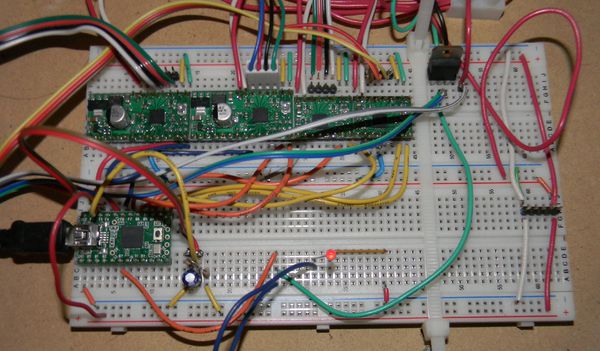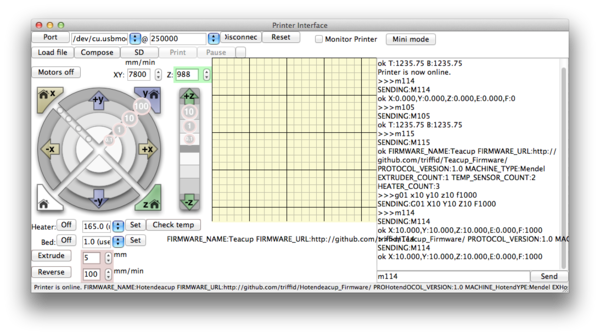Teensy Breadboard
Teensy Breadboard
Combines a $16 ATmega32U4 based carrier from http://www.pjrc.com/teensy with Pololus on a solderless breadboard. Runs Teacup through integrated USB using LUFA serial at 38400 baud. (Teensy is capable of 12MBit/sec communication per [[1]]. Tested at 230400 baud with CoolTerm, and 250000 Baud with Pronterface with modified Teacup using Teensy's usb_serial* routines.) Possible upgrade path to the AT90USB1286 on a $24 Teensy++ towards Teensylu and Printrboard compatibility. Possible upgrade path to a $19 32 bit ARM Cortex-M4 48MHz processor on Teensy 3.0, http://www.pjrc.com/store/teensy3.html
Philosophy
Some of the most expensive parts for a RepRap are the steppers and stepper drivers. If you settle on either NEMA14 or NEMA17 steppers, you can buy them early with some stepper drivers and maybe play with them with an eye towards other projects or any of a number of different RepRaps before committing to a specific design.
Price, committment, end-of-lifecycle-wise, $13*4 for the drivers + $16 for the CPU and $8 for a couple of Protected Mosfets gets you most of what you need for the electronics for only $75 worth of reusable components.
On the electronics side, it all fits in a solderless breadboard with a little usb-capable carrier like the Teensy. The Teensy 2.0++ might be easier to build firmware for, since it matches the atmega1286usb chip already used in the in the Teensylu and Printrboard. I used the smaller Teensy 2.0 since I already had a couple.
The design is future proof in that you could easily add a couple more axes or extruders, or an upgraded processor, following the development of RepRap.
Firmware
- Teacup/Gen7 branch: https://github.com/triffid/Teacup_Firmware/tree/Gen7
- I have some modifications are in https://github.com/drf5n/Teacup_Firmware/tree/Gen7 but the main Gen7 branch works.
Here's a screenshot of Teacup/Gen7 working on a Teensy 2.0:
Pinout
My pinouts from https://github.com/triffid/Teacup_Firmware/blob/Gen7/config.teensy.h :
/*
Machine Pin Definitions
- make sure to avoid duplicate usage of a pin
- comment out pins not in use, as this drops the corresponding code and makes operations faster
Teensy http://www.pjrc.com/teensy ATMega64U4 carrier:
DaveX plan for Wallace:
USB
GND GND |-----#####-----| +5V ATX +5SB
ATX PS_ON 0 |b0 ##### F0| 21 A0 Extruder TC
X_MIN 1 |b1 f1| 20 A1 Bed TC
Y_MIN 2 |b2 /=e6 f4| 19 A2 Stepper -ENABLE (or -SLEEP)
Z_MIN 3 |b3 * * f5| 18 A3 STEP X
PWM 4 |b7 aref=/ f6| 17 A4 DIR X
PWM 5 |d0 f7| 16 A5 STEP Y
6 |d1 b6| 15 A6 PWM DIR Y
7 |d2 V G R b5| 14 A7 STEP Z
Fan 8 |d3 d c n S d b4| 13 A8 DIR Z
Bed Heat PWM 9 |d6 5 c d T 4 d7| 12 A9 PWM STEP E
Extruder Heat PWM 10 |d7 * * * * * d6| 11 A10 (led) DIR E
--------------------
23 ^ \ \----22 A11
\------ RST
Interior E6: 24, AIN0, INT6
Interior Aref : Aref
End d5 : 23
End d4 : 22, A1
With This configuration there remain 4 (or 7, if you count the three holes in the interior) IO connections leftover.
Options
- The version shown above shows a Teensy 2.0, a couple Pololus with voltage regulators, a couple regular Pololus, a single heater output for the extruder, no endstops, and a single thermistor circuit. The Pololus are fed 12v through separate lines.
- The $24 Teensy 2.0++ uses an AT90USB1286, which matches the Teensylu and Printrboard chips, which may make compiling and configuring a firmware easier. It also has lots of extra IO pins.
- The Teensy 2.0 has 25 IO pins, 12 of them can do analog input, while 7 of them do PWM output, which is more than enough for the 15 pins required for 4 steppers, 2 heaters, 2 thermistors, and 3 endstops.
Discussion on first build
- 2012-09-29The original thermistor circuit is pretty noisy, with successive dT up to ~10C. The thermistor is fed off of the +5 rail supplied by an ATX power supply, and uses a 4.7uf capacitor, small relative to other electronics. Using a regulated 5V supply and a 10uf capacitor as in Ramps#Schematic or Sanguinololu may help with the noise. Alternately, you could filter it in software as in https://github.com/triffid/Teacup_Firmware/blob/Gen7/temp.c#L292

